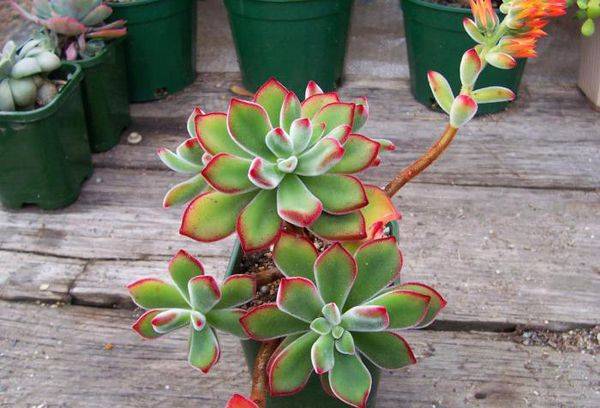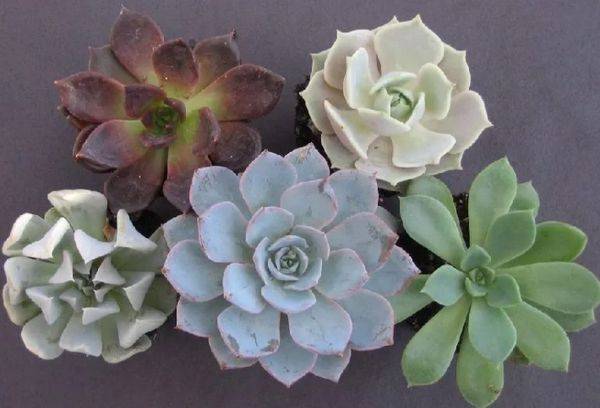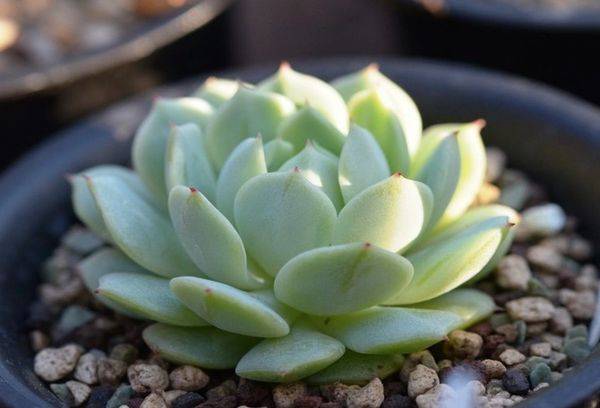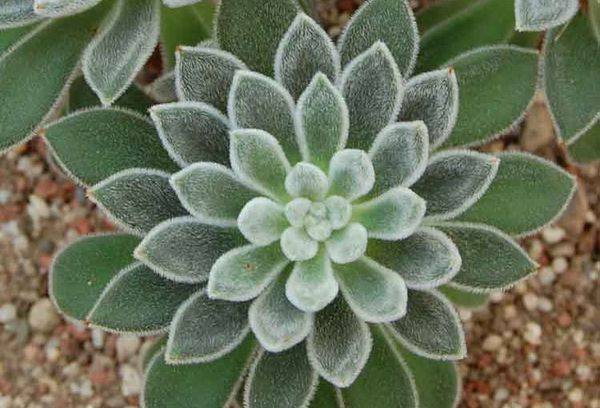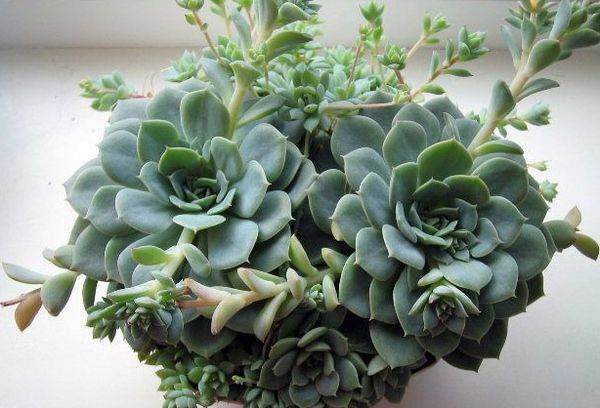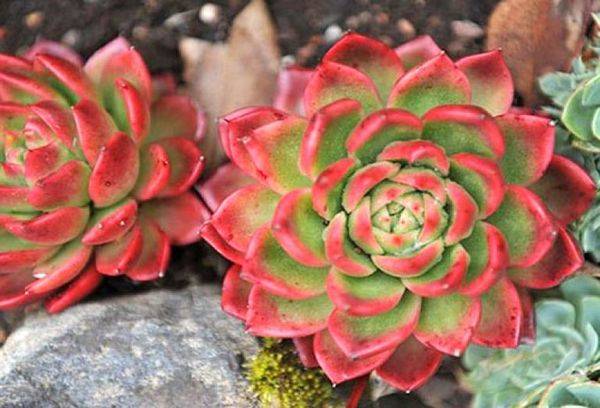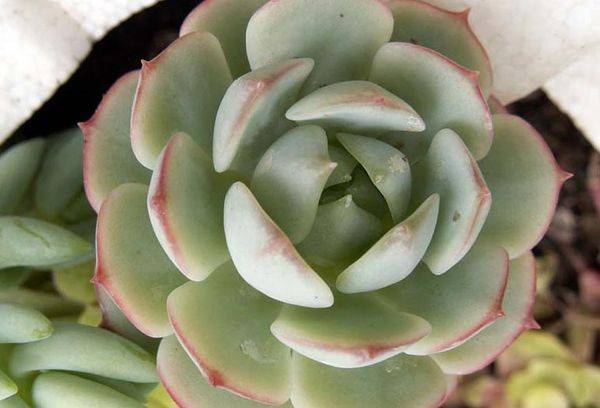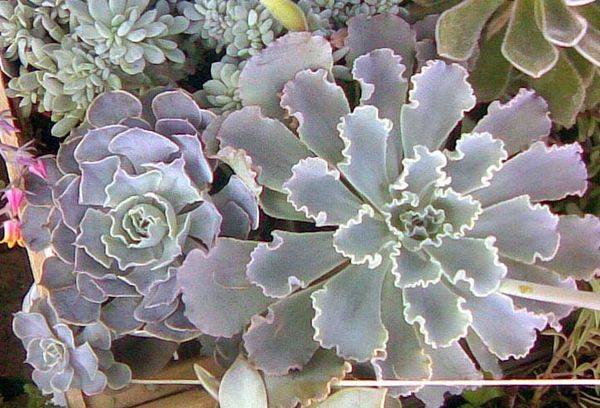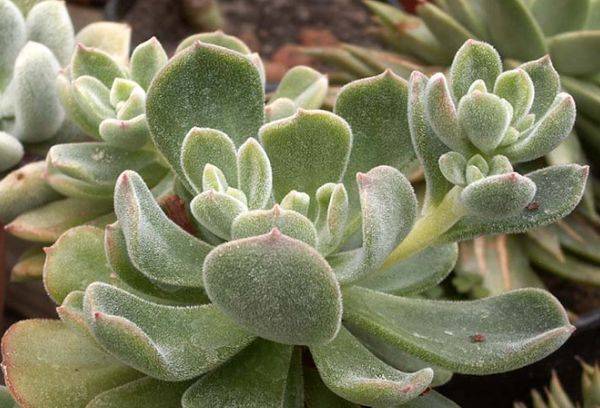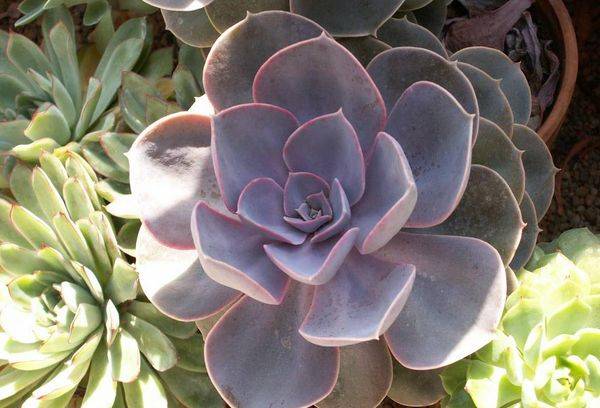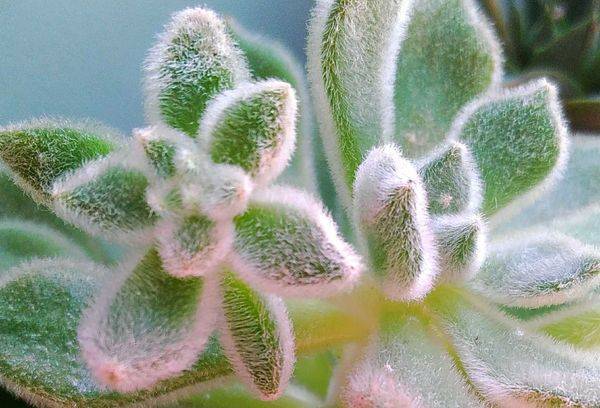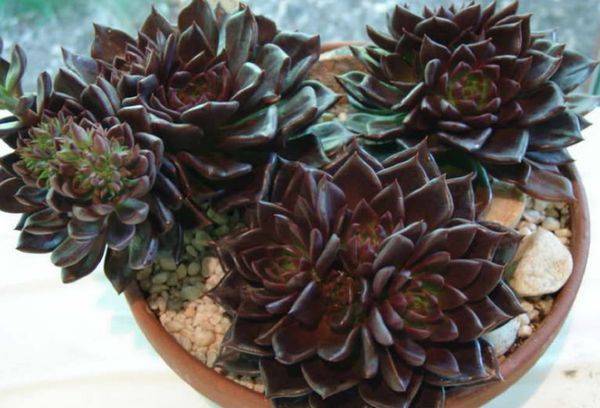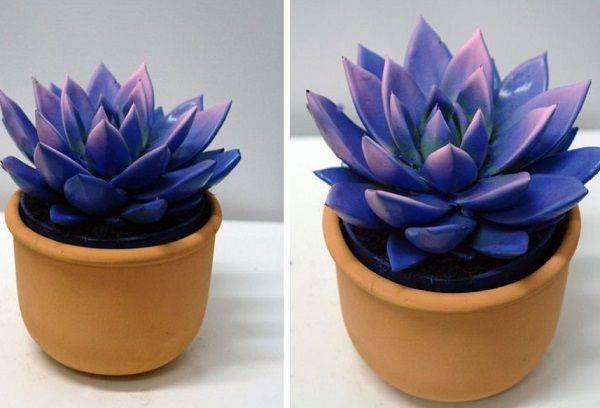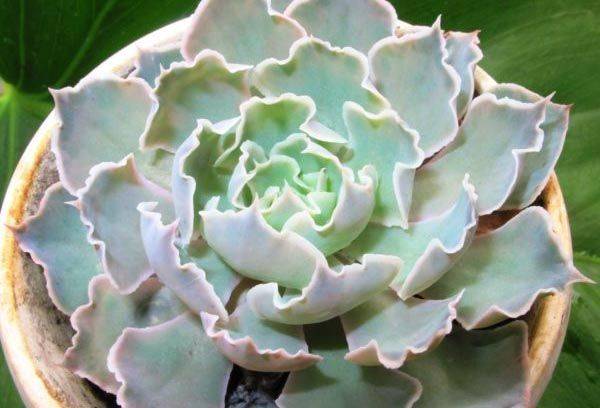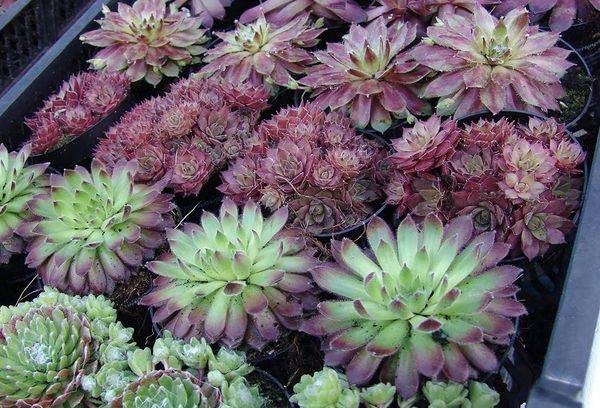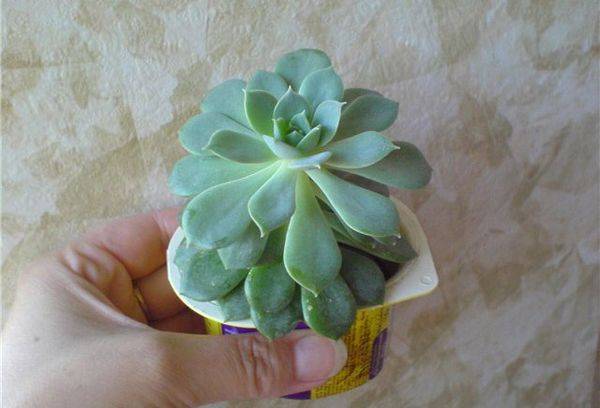Stone rose - care for echeveria at home
Content:
Mexican guest of window sills with an unusual shape of fleshy leaves, one of the most amazing succulent plants - echeveria. It is easy to maintain and requires only two rules: proper watering and enough light. Read more about the preferences of spectacular succulents in our article.
general information
Echeveria (Echeveria, Echeveria) is an evergreen shrub succulent from the family Crassulaceae. The plant is a rosette, gathered in a spiral from dense fleshy leaves of various shades (usually greenish-bluish), so that it resembles a rose. This similarity has been repeatedly noted by gardeners. Echeveria leaves are both smooth and pubescent, with a pointed tip, their length in some species reaches 25-30 cm, and their width is 15. The stem of the plant is so shortened that it seems as if the rosette of leaves "sits" on the ground, but long stem species. The root system of the succulent is superficial fibrous.
An interesting feature that combines all types of echeveria - there is a protective coating on the surface of the sheet. It happens in the form of a wax coating or velvety pubescence. Thus, the plant is protected from direct sunlight and temperature extremes. If the amount of light increases, the plaque thickens.
Echeveria flowers distinguish it from other succulents. These are bells collected in inflorescences on a high stalk and usually having a bright color: scarlet, orange, yellow-green. In the inner part of the flowers are more saturated shade. They appear in the spring or summer and adorn the plant for up to two months. There are species that give buds in winter. Depending on the variety, the length of the peduncle can reach 90 cm.
Homeland plants - Mexico, USA and some countries of South America. In the wild, the flower prefers to settle on rocky rocky soils. It lives on the plains and in mountainous areas in conditions of drought and a lot of sunlight. In indoor floriculture, the plant has gained popularity relatively recently. There are about 150 species of echeveria. And only a few of them are suitable for home use.
Varieties
With the help of interspecific crossing, interesting varieties of echeveria, differing from each other in size, color, and leaf shape, were able to be bred. In the culture, the following varieties of echeveria are grown:
- Graceful - the most common type. It is popular with flower growers due to its bluish-green, almost white rosette of leaves with an elegantly pointed tip. This perennial grows on a thick erect stem. Flowers of graceful echeveria - orange-red, with a yellow top, collected in inflorescences in the form of a brush.
- Agave - stemless rosette of leaves, resembles a star. The species has an interesting color: the leaf plate is light green, decorated with a red stripe along the edge. Blooms in small yellow-red flowers.
- Lau - also stemless echeveria, the rosette is formed by large fleshy white leaves with a pronounced waxy coating. The diameter of the plant is up to 20 cm. It blooms with large orange flowers. Not the most unpretentious look, but takes root in the apartment with proper care.
- White hair - view with large leaves covered with white villi. On a long arrow bright orange large flowers unfold.
- Humpback-colored Echeveria - The owner of a straight high stalk, on which there is a dense rosette of leaves.Their feature is a wavy edge. Peduncle with pink flowers reaches about a meter in height.
- The echeveria has a brilliant shovel-like wavy leaves of a gray-green hue. Red flowers on a long peduncle appear in spring - early March.
- Echeveria Derenberg It is a dense meaty rosette on long creeping stems, collected from light green leaves with red tips. Flowers - yellow-red, appear in late spring.
- Echeveria Peakotsky - succulent with a sedentary outlet. Triangular bluish-gray leaves are decorated at the tips with red stripes. The flowering period is the end of spring, the flowers are red with a white bloom.
- Cushioned - a variety with triangular bright green leaves with silver pubescence. There is a spine at the end of the leaf plate.
- The Pearl of Nuremberg - a hybrid with pinkish-gray leaves. At home, does not bloom.
- Bristly - A view with spherical rosettes of more than one hundred small fluffy leaves. They have a delicate olive shade and a sharp tip. Such echeveria blooms in summer with yellowish flowers.
- Black Prince - An interesting variety with green-brown fleshy leaves and alo-chocolate flowers.
- Echeveria Miranda differs in various shades: yellow, pink, lilac, scarlet. The shape of the outlet resembles a lotus.
- Shaw (Shaviana) - The owner of thin leaves with an expressive wavy edge. On erect peduncles pink-yellow neat flowers are formed.
Getting started: placement in the house
Care for echeveria is minimal, but you should not forget about it: the plant, surrounded by attention, acquires resistance to diseases. Handling requires leaves. They are very fragile and may suffer from inaccurate movement. The rest is succulent unpretentious.
Growing echeveria begins with its placement in the house. This plant is thermophilic, it calmly tolerates direct sunlight, which distinguishes it from many others. This rare resistance is explained by a special coating of foliage - villi or plaque. Place the flowerpot on a south, east or west window without shading. The north side is best avoided: there will not be enough light for the flower.
After winter, you need to accustom echeveria to the sun gradually, especially young plants (they can get a sunburn). And in the warm season, the flower will gladly move to the open air. It is only necessary to protect it from rain and return it to the premises in time with the onset of cold weather. The optimum temperature for growing is + 22-27˚ C in the summer and + 8-15˚ C in the winter. If you have a winter-flowering variety, then make sure that the room is warm, like in summer.
A sufficient amount of light stimulates the budding of the echeveria. Most varieties bloom indoors, flowering time - May-June, 2-3 weeks in a row. Plants need a 12-hour daylight, regular watering and a temperature of +15 to +18 degrees. Fertilizing will also contribute to the appearance of a peduncle.
Humidity, watering, fertilizers
Dry air is a comfortable environment for succulents. Spraying both the plant and the spaces around it are not carried out. Excess moisture often leads to decay of the leaves; they lose their wax coating, become less resistant to sunlight. It is allowed to wipe the leaves of non-pubescent varieties with a damp rag to protect the plant from the appearance of pests.
Poured echeveria with soft, settled water. In the summer - 1 time in 7-10 days, as the soil dries. In winter, watering is reduced to 1 time in 1-2 months.
Tip
Do not allow water to enter the leaf outlet so that the echeveria does not begin to rot. And do not forget to drain excess fluid from the pan.
Fertilization begins in March and is done no more than once a month. The magazine purityis.decorexpro.com/en/ draws attention to the fact that with an excess of fertilizers, the root system often suffers, including a burn.After the echeveria fades, top dressing ceases. Echeveria fit standard fertilizers for cacti and succulents, taken in half concentration.
Seating
Succulents are propagated in two ways:
- leaf
- sockets.
The leaf plate is separated from the mother plant with a knife. To avoid rotting, the cut is dried for about a week. After that, the sheet with the outer side is placed on wet soil. The rooting temperature is about 25 degrees Celsius. When a small outlet appears, the plant is transplanted into a separate container.
Reproduction by sockets is a more convenient and popular way. The daughter outlet is carefully separated from the plant, the slice is treated with charcoal and dried for 24 hours. Next, they plant the outlet in wet sand and wait for rooting. Echeveria propagated in this way used to produce peduncles.
How to transplant
A succulent just purchased requires an emergency transplant. The fact is that the soil for sale is not designed for a long preservation of the normal life of the echeveria. In the future, transplantation is carried out every 2-3 years. Echeverias are grown in universal soil for succulents. To make the soil yourself, take in equal proportions coarse sand, sheet and turf soil, add broken brick. Capacity - low, ceramic, with drainage holes.
Transplant Procedure:
- pour a drainage layer on the bottom of the container (approximately 1/4 of the pot);
- bake the soil mixture and put in a container;
- remove echeveria from the old flowerpot, remove rotten and dried parts;
- process the cuts with charcoal;
- moisten the soil and deepen the plant into it;
- resume watering a week after transplanting.
Possible problems
Echeveria rarely gets sick and is affected by pests if proper care is provided. Due to a violation of the rules, flower growers face the following difficulties:
- Slowing down and fading leaves. The reason is a lack of moisture and nutrients. Perhaps it's time to move the succulent to a new container, since the old one is small.
- Rosette leaves wrinkled. The reason is lack of water. After watering, move the affected plant to a less hot place.
- The rosette stretches out, the leaves turn pale - signs of a shortage of sunlight.
- If the leaves and stems turn black, reduce watering and increase the temperature in the room. Protect echeveria from drafts, remove dead parts.
- The appearance of spots on a sheet plate is possible after water drops fall on it. Another reason is mechanical damage.
- Leaves turn yellow due to stagnant soil moisture.
Pests and diseases of eheveria:
- Root worm Starts up due to improper watering. The plant stops in development, the leaves wither. Immediately transplant the succulent into a new soil and treat it with an insecticide.
- Mealybug. Leaves at the base are covered with white downy plaque. If the pest did not have time to spread, the plant can be saved with insecticides or a soap solution. A heavily damaged plant will have to be thrown away, leaving whole cuttings for planting.
- Root rot. Signs: the roots turn black, the leaves turn yellow and fall off. Cut off all diseased roots, treat the slices with charcoal, dry them, then plant the succulent in a healthy soil. For prevention, it is recommended to periodically water the soil with a fungicide solution.
Echeveria in the florarium
Echeveria looks good in the florarium - a small greenhouse for ornamental plants. It creates a landscape similar to the original desert or semi-desert, where succulent dwells. For cultivation, a mix of different varieties of echeveria is collected or combined with other plants similar in care:
- lithops
- haworthia
- fat woman
- Kalanchoe
- cacti
- young man.
For the manufacture of florarium, a glass container is taken and processed from the inside with alcohol.The drainage layer is filled up to a quarter of the height, and disinfected soil to the same amount. Prepared succulents are planted in the florarium, and free space is drawn up.
Tip
Decorate the composition with colored sand, moss, bark, decorative stones, glass and shells.
Water the plants with a small watering can and in smaller volumes than succulents growing in pots. Over time, the flower arrangement will outgrow the capacity, and you will have to transplant everything into a more capacious florarium.
Interesting to know
Perhaps you did not know the following about echeveria:
- At home, it is called a stone rose. Among the names of the flower there is also "rabbit cabbage" and "tenacity".
- Echeveria is often confused with another plant called young. Both species belong to the same genus, but the juvenile has a thinner and lighter leaf plate, is more resistant to low temperatures and propagates with the help of a mustache with daughter rosettes. Echeveria is thermophilic, does not tolerate a lack of light, and her children are formed at the base of the stem.
- The plant itself has neutral energy, but if you surround it with care, then a cozy atmosphere is provided to you.
- According to psychics, echeveria is a talisman. She protects the owner and his house from black magic.
- Succulent has medicinal properties. At home, it was used as a remedy for kidney diseases, bronchitis, colds. From ancient times, the infusion of Echeveria leaves was taken as a sedative.
Cultivating eheveria is an interesting activity for both beginners and professionals. The only difference is that experienced flower growers can more confidently experiment with the plant, planting it as part of a flower arrangement. Observe the minimum requirements for care, and your home will be decorated with an exotic beauty for a long time.
